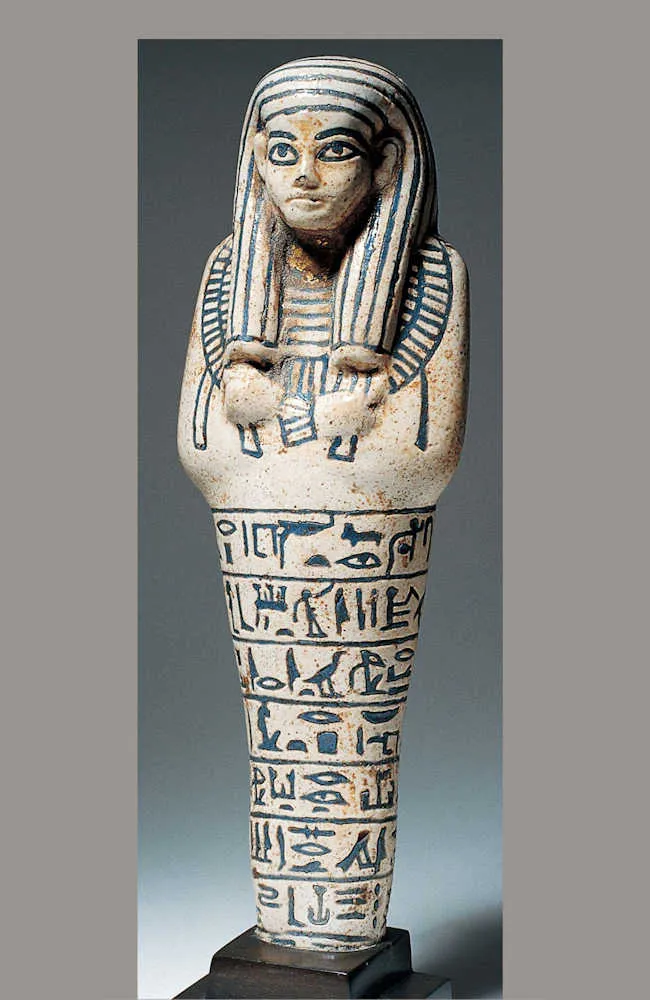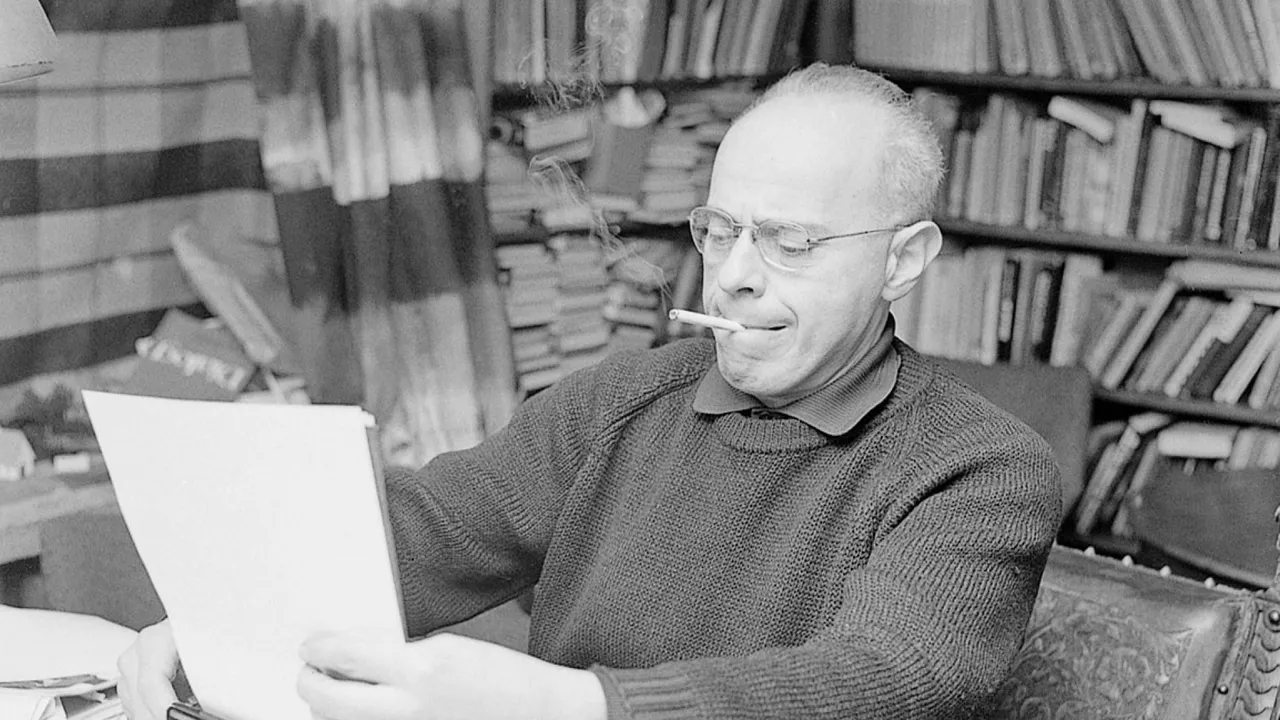In Deutsch
Anderntags wurde ich auf eine Kolumne aufmerksam gemacht, die meine Neugierde weckte. 1. Da verknüpft der Autor Peter Glaser mit einem Augenzwinkern den historischen Ursprung der künstlichen Intelligenz mit den Grabgebräuchen der alten ägyptischen Reiche, und gibt einen Ausblick in die Zukunft mit Stanislaw Lem und seiner Kurzgeschichte von schönen Frauen die Waschmaschinenroboter sind. Klingt einleuchtend, oder?
Ich erläutere mal ein wenig.
In den Gräbern der Pharaonen und dem hohen Stand der Priester und Gelehrten fand man kleine Figuren als Beigaben. Diese entzifferte man als Ushebtis (die Antwortgebenden): Helfer im Jenseits.

Zunächst aus Wachs gestaltet, kamen später auch hölzerne, steinerne oder aus Fayence gestaltete hinzu. Diese Figuren waren so geformt, daß sie verschiedene Werkzeuge, bzw. Erkennungssymbole trugen und zusätzlich mit in Hieroglyphen verfassten Befehlen bestückt wurden. Das drückte ihr Aufgabengebiet und ihre Anweisung aus. Denn sie sollten im Jenseits (in der Unterwelt) die harten Arbeiten abnehmen, damit sich die edlen Geister der Verstorbenen den höheren Dingen widmen können. Manchmal auch als Entlastung, da die verstorbenen Pharaonen und Priester nicht alleine die Arbeit bewältigen könnten.
Die zeremonielle Instruktion, mit der die Figuren beschriftet waren klingt tatsächlich wie eine dialogorientierte Benutzerführung. Ich zitiere:
Magische Puppe, höre mich an! Wenn ich gerufen werde, die Arbeit auszuführen … Wisse, du bist an meiner Stelle von den Hütern der Unterwelt verurteilt, die Felder zu besäen (/die Kanäle mit Wasser zu füllen/den Sand herbeizuschaffen). Hier bin ich und höre auf deine Befehle!
Irre, gell?
Natürlich gab es damals noch kein C++ und die Priester haben sich etwas gänzlich anderes dabei gedacht. Das Weltbild der alten Ägypter war magisch geprägt und es galt als Selbstverständlichkeit, daß der Mensch aus Geist (Ka-Manchmal auch als Lebenskraft interpretiert), Seele (Ba) und Körper bestand. Beim Tod wandert die Seele in die Unterwelt und hat Prüfungen zu bestehen um die Göttlichkeit, bzw. Ewigkeit zu erlangen. Demzufolge waren die Ushebtis nicht einfach schicker Schmuck als Statussymbol beigelegt, sondern als reale, magisch hergestellte Wesen, die im Jenseits nur die ihnen imprägnierte Aufgabe zu erfüllen haben. In der magischen Literatur der kommenden Jahrtausende pflanzte sich diese Idee fort und mit ihr vielerlei Rituale, die man auch noch heute in diversen Publikationen finden kann. Ob die Autoren da auch immer richtig abgeschrieben haben sei dahingestellt, aber es bildeten sich allerlei Zirkel mit ernsthaften Absichten, die solche altägyptischen Rituale noch heute ausführen in der Hoffnung … nun ja; schwer zu sagen. Die sichtbaren Vertreter moderner Magie sind untereinander ziemlich verstritten. Jedenfalls kann man sich mit etwas Fantasie diese Ushebtis als ideelle Vorgänger heutiger Roboter mit künstlicher Intelligenz vorstellen. Sie waren Hardware, die ihrer Software gehorchen mußten.
Es gäbe noch so viel zu entdecken aus dem alten Reich der Ägypter: ihre Schriften, ihre Religion, ihr alltägliches Leben, aber das führt jetzt zu weit. Mich hat es zumindest so angestachelt, daß ich den Rest des Abends mit dem Thema beschäftigt bin. Faszinierend!
Ach ja; da waren noch die schönen Frauen und die Waschmaschinenroboter. Nun, Stanislaw Lem hat in seiner unnachahmlichen Weise eine Kurzgeschichte verfasst, in der zwei Waschmaschinenhersteller in der Zukunft sich gegenseitig mit ihren Produkten überbieten. Während die eine Maschine die Wäsche waschen, bügeln, frottieren und mit schönen Stickereien verzieren kann, toppt der andere Hersteller mit einer neuen Maschine, die Vierzeiler dichten und sticken kann. Natürlich toppt der erste Hersteller mit neuen Features und so geht es weiter, bis eines Tages ein Waschmaschinenhersteller einen Waschmaschinenroboter für die Zielgruppe Junggesellen auf den Markt bringt, der eine schöne Sexbombe darstellt. Das eskaliert immer mehr und irgendwann weiß niemand mehr wer Roboter und wer Mensch ist. Und es entwickelt sich auch ein Rechtsstreit mit einem „Planeten“, da die Maschinen sich nun selbstständig machen und ein Kult entsteht. Mehr will ich nicht verraten. In seinem Buch „Sterntagebücher“ findet ihr die Geschichte „Die Waschmaschinen-Tragödie“. Mit Witz und Humor philosophiert Stanislaw Lem im Gewand einer Science Fiction Geschichte über die tieferen Auswirkungen der KI unter den Menschen, und womit sich diese überforderte Menschheit auseinandersetzen muß. Es ist eine absolute Leseempfehlung! Die kleine Kolumne ebenfalls.

So, dann widme ich mich jetzt dem Abendessen und ziehe mir für den Rest des Abends Dokus rein.
Danke fürs Lesen :)
PS: Wer sich ein Ushebti für seine Beerdigung kaufen will (man weiß ja nie wozu es gut sein kann), der findet welche hier: https://aton-gallery.com
Für mehr Information besucht: https://www.ushabtis.com
In English
The other day, I was alerted to a column that piqued my curiosity. 1. There the author Peter Glaser links with a wink the historical origin of artificial intelligence with the burial customs of the ancient Egyptian empires, and gives a glimpse into the future with Stanislaw Lem and his short story about beautiful women who are washing machine robots. Sounds plausible, doesn't it?
Let me explain a little.
In the tombs of the pharaohs, the high status priests and scholars, small figures were found as grave goods. These were deciphered as Ushebtis (the answer-givers): Helpers in the hereafter.

Initially made of wax, they were later manufactured as wooden, stone or faience figurines. These figures were formed in such a way that they carried different tools, or recognition symbols and were additionally equipped with commands written in hieroglyphics. This expressed their task and instruction. For they were to take off the hard work in the afterlife (in the underworld), so that the noble spirits of the deceased could devote themselves to higher things. Sometimes also as a relief, since the deceased pharaohs and priests could not manage the work alone.
The ceremonial instruction with which the figures were labeled actually sounds like a conversational user prompting. Quote:
Magic doll, hear me! When I am called to do the work ... Know, you are condemned in my stead by the guardians of the underworld to sow the fields (fill the canals with water/bring in the sand). Here I am, obey your orders!
Crazy, right?
Of course, there was no C++ at that time and the priests had something completely different in mind. The world view of the ancient Egyptians was magical and it was taken for granted that the human being consisted of spirit (Ka-sometimes interpreted as life force), soul (Ba) and body. At death, the soul wanders into the underworld and has to pass tests to attain divinity, or eternity. Accordingly, the Ushebtis were not simply fancy jewelry attached as a status symbol, but as real, magically produced beings, which in the afterlife have only to fulfill the task impregnated to them. In the magical literature of the coming millennia this idea was propagated and with it many rituals, which can still be found today in various publications. Whether the authors have always copied correctly is left open, but all kinds of circles with serious intentions were formed, which still perform such ancient Egyptian rituals in the hope ... well; hard to say. The visible representatives of modern magic are quite at odds with each other. Anyway, with a little imagination, one can imagine these Ushebtis as ideal predecessors of today's robots with artificial intelligence. They were hardware which had to obey their software.
There would be still so much to discover from the old realm of the Egyptians: their writings, their religion, their everyday life, but that is subject for another post. At least, it spurred me on so much that I will spend the rest of the evening on the subject. Fascinating!
Oh yes; the beautiful women and the washing machine robots were still to mention. Well, Stanislaw Lem, in his inimitable way, wrote a short story in which two washing machine manufacturers in the future outdo each other with their products. While one machine can wash, iron, terry and decorate laundry with beautiful embroidery, the other manufacturer tops it with a new machine that can write quatrains and embroider. Of course, the first manufacturer tops with new features and so it goes on, until one day a washing machine manufacturer launches a washing machine robot for the target group of bachelors, which is a beautiful sex bomb. This escalates more and more and at some point no one knows who is robot and who is human. And it also develops a legal dispute with a "planet", because the machines now make themselves independent and a cult arises. I don't want to give away more. In his book "Star Diaries" you will find the story "The Washing Machine Tragedy". With wit and humor Stanislaw Lem philosophizes in the garb of a science fiction story about the deeper effects of AI among humans, and what this overburdened humanity has to deal with. It is an absolute reading recommendation! The little column as well.

So, I'll devote myself to dinner now and watch documentaries for the rest of the evening.
Thanks for reading :)
PS: If you want to buy a Ushebti for your funeral (you never know what it can be good for), you can find some here: https://aton-gallery.com
For more information check out: https://www.ushabtis.com